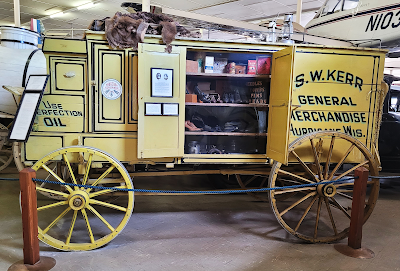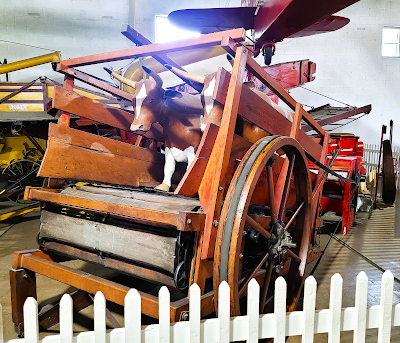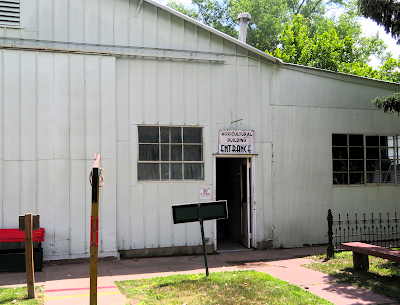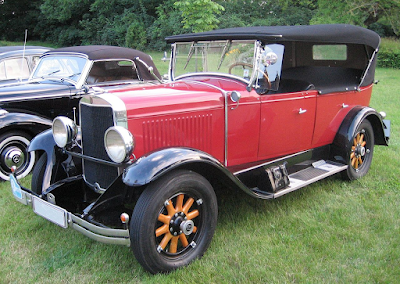…and finally, my last post about our tour/exploration of Harold Warp’s Pioneer Village in Minden Nebraska. I’ll end this series of posts with the very late lunch/early dinner we had on the way back to Omaha.
There
were a few items and collections that I’d missed or skipped over before…and
I’ll mention other exhibits and collections that we just didn’t take photos of.
This is a
1934 Harley-Davidson Model VLD. With the
onset of the Great Depression, sales of motorcycles were hard to come by. In an effort to cut costs and increase sales,
Harley eliminated chrome trim, substituting black paint. This model had its shift lever mounted on the
gas tank. A total of 4,527 Model VLD’s
were built, selling for $310 each. A
1934 H/D VLD sold this year through Hemming’s Auctions for $21,000.
We didn’t
tour the second floor of the building where motorcycles, bicycles and more are
on display but I’ve seen photos of both…and the floor is jam-packed with
goodies.
This
beautiful red 1905 Buick Model C is the oldest Buick in existence! It is equipped with a 2-cylinder motor that
produces 22 HP. Its frame is made of
wood and it was built in Jackson Michigan (my hometown). The price tag for the Model C back in the day
was $1,200. (About $42,000 in today’s dollars)
This is an illustration showing the huge Buick manufacturing plant in Jackson Michigan that I borrowed from the Internet. Buick built automobiles in Jackson from 1905 until 1912 when it focused all its operations in Flint Michigan. Jackson was the home of 25 different car manufacturers from 1901 until 1954. Buick is the only brand name to have survived over the years. As a youngster, I knew that some auto manufacturing was happening in Jackson, but most of it was related to parts and accessories.
…but,
once again, I digress...
Back to
the exhibits at Pioneer Village. This is
a 1914 2-passenger Saxon. It cost $395,
the equivalent to $11,696 in 2022, and it was billed as “A Good Low
Priced Car”. This particular version
includes a couple of options…electric lights and an electric starter. A total of 7,000 of these cars were built in
the first year of production.
In 1914,
a Saxon roadster was driven 135 miles a day for 30 days straight. Total miles covered was 4,050 and it averaged
30 miles per gallon. It was among the
first cars that ‘christened’ the then new transcontinental Lincoln
Highway…primarily US Hwy 30 today.
The Saxon
Motor Car Company was located in Detroit Michigan and it was in operation from
1914 to 1922 when it over expanded and got into serious financial
difficulties. In 1917, Saxon built
28,000 cars, making it the seventh largest car maker in the USA.
This is a
1909 E-M-F 30. Note the lap robe on the seat for warmth... This 2-seat coupe was
built in Walkerville Ontario although the company had plants in the USA as
well. The E-M-F Company produced cars
from 1909 to 1912. The name E-M-F came
from the initials of the 3 founders of the company. The E was for Barney Everitt, an auto-body
maker. The M was for William Metzger,
who had been with Cadillac. Finally, the
F was for Walter Flanders, who had worked for Henry Ford as his production
manager. The company was folded into the
Studebaker Company which shortly afterwards, stopped using the EMF brand name.
Exhibits
at Pioneer Village pertaining to Native American culture are limited as the
focus of the museum is the growth and progress of the country from 1830 into
the early 1960s. Much of the 'progress' and innovations noted came at the expense of Native Americans. Nevertheless, I did note this showcase of
Native American artifacts in the main building at Pioneer Village. Included are pottery items, tools, beads, a
ceremonial headdress and what appears to be 2 ceremonial tomahawks. That item at the front of the case is a hide
scraper.
The
Algonquian people created the tomahawk.
The word Tomahawk is derived from Powhatan ‘tamahaac’. Originally, Native Americans would use
sharpened stones secured to wooden handles using strips of rawhide. The tomahawk quickly spread from the
Algonquian culture to the tribes of the South and Great Plains.
As I’ve emphasized several times, there is little that Harold Warp and his Pioneer Village didn’t collect that is representative of European American life, growth and expansion beginning in 1830.
The
“Cigar Store Indian” in the first photo once stood in front of a Chicago Cigar
factory. It was wheeled out to the
sidewalk every day from 1875 until 1902.
It was found in a Chicago basement 50 years later. These ubiquitous carved wooded sculptures
actually became popular with the demise of ship’s figureheads. American tobacconists started buying the
figureheads…especially American Indians…to advertise their shops. At one time, there were over 75,000 “Cigar
Store Indian” sculptures across the USA.
They lost their popularity in the early 1900s.
The cast
metal Native American (unfortunately covered by signs) was cast in the true
likeness of an Indian chief in Wisconsin.
A lumber executive made friends with the chief and had the cast made ca.
1850 to keep peace with the tribe. The
goal of course was to cut as much timber from the tribe’s hunting grounds as
possible. The figure is wearing a
capote. A capote is a wool blanket
fashioned into a sort of coat to provide a means of dealing with harsh winters
and they served as winter outerwear for First Nations.
This is
the last automobile, I promise! It’s a
1915 Moon touring car with a “double cowl Delaumay-Belleville” body
design. This style, it was claimed, “is
usually associated with higher priced European models”. It even had Spanish leather upholstery! Three models were available ranging in price
from $1,395 to $1,750 for the 6-66 combination touring and club roaster.
The Moon
Motor Car Company, founded in St. Louis Missouri in 1905, had a venerable
reputation among the discriminating auto buying public. One early model…a true luxury car…sold for
$3,000 or about $94,500 in todays dollars.
The company came to be known for fully assembled, easily affordable cars
using high-quality parts. They were
expensive to build with the intensive hands-on attention to detail. The company built both cars and trucks, almost
60,000 vehicles in total. The company
went out of business in 1930. It is said
that Moon autos were exported to 47 different countries.
This
Peddler’s Wagon was recovered from a shed in Wisconsin where it had been stored
for about 70 years. Two mature trees had
to be cut down to remove it after all those years. Peddler’s wagons were very common between
1840 and about 1880 as they sold, bought and traded products with settlers
across the mid-west and plains states.
S.W.
Kerr’s daughter learned that Harold Warp had recovered the wagon and that it
would be on display at Pioneer Village.
She was very happy to learn that her dad’s wagon had found a home and
would be there for all to see. Her
family was from Hurricane Wisconsin…named after a local mine. Back around 1900 the town had a cheese
factory, sawmill, blacksmith, grist mill, post office and the S.W. Kerr General
Store.
Mr. Kerr
would use a 3 horse hitch on the wagon and he’d roam the countryside selling
and trading. He’d sell or trade
groceries, kerosene, dry goods, clothing/shoes, hardware and more. He’d obtain eggs, animal hides, wild rabbits,
crates of chickens and other farm products in exchange for the offerings on the
wagon.
Note: Laurie ran across this video on Facebook of a horse powered threshing machine at a 'threshers' gathering from earlier this year. Very interesting to see just how it was done before engines were used... Check it out at: https://www.facebook.com/reel/324172843619987. You'll need to copy and paste this in your search bar.
OK…The
last building we explored was the Hobby House.
It is the only building where Mr. Warp didn’t try to display
collectibles in chronological order. As
I’ve stated many times, Harold Warp collected just about everything.
How about
the ‘button collection’! There are
wooden alphabet letters hanging on the wall with each letter covered with 200
to 300 buttons. There also is a
miniature rocking chair, wheelbarrow, wind mill, water well, a star and a
covered wagon…all made with wood and covered with bunches of buttons. My favorite was the ‘button dress’.
So what
other Pioneer Village items didn’t I feature?
How about outboard motors, dolls, tools, patches, snowmobiles, several
more aircraft, parking meters, gas pumps, seeding and planting farm equipment
and one of my favorites, a very large collection of horseshoes.
Any other
weird and wonderful exhibits? Well, yes
there are! The Hobby House has this huge
collection of pens as well as salt shakers, ashtrays, pencils, liquor
decanters, mechanical banks, nightcaps and spittoons.
Other
items that we didn’t feature in our tour include Currier and Ives prints, the
William Henry Jackson paintings, the carousel animals, radio and TV vacuum
tubes, fishing trophy mounts and fishing equipment, porcelain figures, famous
American figurines…and more!
The
Television Show, “American Pickers” visited Pioneer Village and bought a few
surplus items earlier this year…and it was featured on one of their shows. The Pioneer Village is now operated as a
501(c)(3) Foundation and is able to receive tax-deductible donations. The goal is to restore and improve Pioneer
Village. State grants have helped and
surplus/duplicate items have been auctioned off to raise money so the Village
can move forward. Other auctions are
planned and hopefully, they will provide needed funds.
To view a
short but interesting video that provides an overview of the Village’s
collections, just go to https://www.bing.com/videos/riverview/relatedvideo?q=Pioneer+Village+-+art+collection&mid=E0D55AEDE0D7C8CDA408E0D55AEDE0D7C8CDA408&FORM=VIRE.
It provides a nice overview of the
Village’s plethora of objects on display…
My family
and I highly recommend a visit to Harold Warp’s Pioneer Village. If you are a collector, a car buff, a farmer,
into history or just like to tour museums, you will enjoy your visit. Admission is amazingly low at $15.00 per
person…especially given their huge and impressive historical collection of
Americana. Website: Home - Pioneer Village - Minden, NE.
…moving
on down the road toward Omaha, we decided to stop for a late lunch in Hastings
Nebraska.
This is
Kitty’s Roadhouse Bar and Grill on US Hwy 6 in Hastings. A grill or restaurant has been located on
this spot since 1958. In 1958 it was
named “Kitty’s” and when the new owners took over in 1972, they decided to stay
with the familiar name…and they just added “Roadhouse” to it.
The bar and dining area is over the top colorful and eye-catching. The racing theme dominates. I thought that the gas pump draft beer feature was something different, or at least I’d never seen it anywhere else.
Kitty’s
Roadhouse offers sandwiches, broasted chicken, pizzas, salads and steaks. A couple of appetizers caught my
attention. They were “Shrimp Jammers”, 7
jumbo shrimp stuffed with Monterrey Jack cheese and served with Sweet Thai
Chili. ($12.99), and; the “Junk Yard Combo Platter” (Full order $17.99/Half
order $12.99). The combo platter
included deep fried mushrooms, cauliflower, corn fritters, onion rings, mini tacos
and French fries.
However,
since it was too early for a dinner with appetizers, salads, steaks and/or
chicken, we all decided to have cheeseburgers with fries. At Kitty’s, you design your own burger combo. In keeping with the racing/auto theme,
burgers are listed as an F-150, F-250 and F-350…with 1 through 3 beef patties.
In this
case, it was double 1/3 lb. burger patties (F-250) on a grilled bun with
pickles and onion. ($9.99) Add tomato and lettuce ($.49), cheese ($.69) and
French fries ($3.99) and this burger platter cost $15.16. The burgers and fries were both above average
and we were ready to hit the road back to Omaha with full stomachs… To see more
about Kitty’s Roadhouse in Hastings Nebraska, just go to Kitty's Roadhouse|Hastings,NE|Wood-Fired Pizza| Broaster
Chicken (kittysroadhouse.net).
Just click
on any of the photos to enlarge them…
Thanks
for stopping by for a visit! Happy Halloween!
Take
Care, Big Daddy Dave

















































